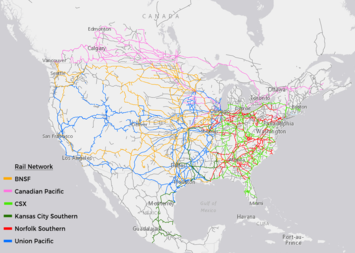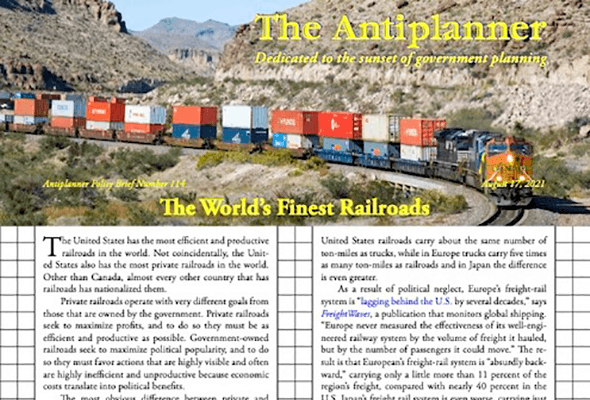
The United States has the most efficient and productive railroads in the world. Not coincidentally, the United States also has the most private railroads in the world. Other than Canada, almost every other country that has railroads has nationalized them.
Private railroads operate with very different goals from those that are owned by the government. Private railroads seek to maximize profits, and to do so they must be as efficient and productive as possible. Government-owned railroads seek to maximize political popularity, and to do so they must favor actions that are highly visible and often are highly inefficient and unproductive because economic costs translate into political benefits.
Click the image above to download a four-page PDF of this policy brief
The most obvious difference between private and public railroads today is that the private railroads of the United States and Canada emphasize freight while government-owned railroads in the rest of the world emphasize passengers. Passenger trains have no comparative advantages over planes, buses, and cars, so they are rarely profitable, leaving private railroads to concentrate on freight. But passenger trains are far more visible to people than freight, so politicians emphasize them despite their inability to earn a profit.
Passenger trains cost more than the alternatives. Amtrak spends more than 60 cents moving someone a passenger mile, while airlines spend less than 15 cents. But the extra cost has political benefits since Amtrak employees and suppliers will vote for and contribute to politicians who support the company’s inefficient operations.
In contrast, moving freight by rail can cost less than trucks, especially if it involves large commodities moving long distances from point A to point B. Trucks do better than rail when moving many small items from many origins to many destinations, but, even then, their costs may be higher, and the main advantage of trucks is that they are faster and able to go from door-to-door. Economically, the appropriate division between goods shipped by rail vs. truck depends on how efficient railroads can make themselves, but in countries where the railroads are government owned there is less pressure for them to be efficient. As a result, in the United States railroads carry about the same number of ton-miles as trucks, while in Europe trucks carry five times as many ton-miles as railroads and in Japan the difference is even greater.
As a result of political neglect, Europe’s freight-rail system is “lagging behind the U.S. by several decades,” says FreightWaves, a publication that monitors global shipping. “Europe never measured the effectiveness of its well-engineered railway system by the volume of freight it hauled, but by the number of passengers it could move.” The result is that European’s freight-rail system is “absurdly backward,” carrying only 11 percent of the region’s freight. Japan’s is even worse, carrying just 5 percent of the nation’s freight.
Deregulation
Aside from private ownership, a key factor in American railroad productivity is deregulation. Before 1980, American railroads may have been private, but they were so heavily regulated they might as well have been public. Regulations strictly governed the amounts railroads could charge, how many people the railroads had to hire, whether they could abandon service to a money-losing route, and many other factors.
These regulations practically drove the rail industry into bankruptcy. In today’s dollars, the class I railroads earned total after-tax net income of more than $10 billion a year in the 1920s. By 1975, this had fallen to barely more than half a billion dollars. The Staggers Act of 1980 gave the railroads freedom to set their own rates, abandon unprofitable routes, and expand service into profitable areas.
Read the rest of this piece at The Antiplanner.
Randal O’Toole, the Antiplanner, is a policy analyst with nearly 50 years of experience reviewing transportation and land-use plans and the author of The Best-Laid Plans: How Government Planning Harms Your Quality of Life, Your Pocketbook, and Your Future.
Photo credit: graphic created with data from Arcgis Maps.













